Finished!
I’m very happy with it.
Have you ever abstracted something like this? I like the effect. What do you think?
Ellen Lindner
 Adventure Quilter
Ellen Lindner uses fabric the way a painter uses paint, with extraordinary results
Adventure Quilter
Ellen Lindner uses fabric the way a painter uses paint, with extraordinary results
Finished!
I’m very happy with it.
Have you ever abstracted something like this? I like the effect. What do you think?
Ellen Lindner
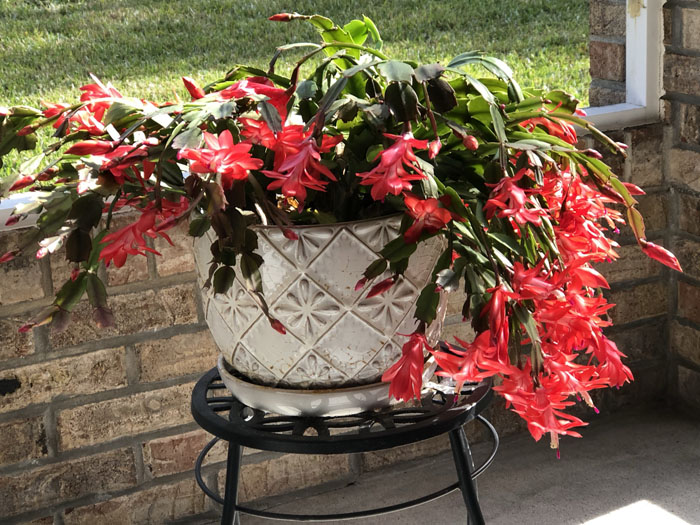
After studying my photo of a Christmas cactus, I decided to try abstracting it with one repeated shape. Maybe something like these “spike” shapes. 
Yes, I thought they worked well.
My original idea was to fill the entire space with this shape, just changing the color for background grass, brick, etc. But, when I tried that for grass I didn’t like it at all. Especially since just a few shapes were so effective.
So, I decided to depict the actual plant only.
Here it’s shown as a square. I thought it would probably be better if I cropped off some of the left area.
From there things fell together easily. Here it is, well under way.
I was loving how it was coming together and I didn’t want to over work it. Audition. Edit. Repeat.
I think I’ll have this one finished quickly. Stay tuned.
Ellen Lindner
P.S. I’m not sure how to quilt the background. I’ll have to give that a good bit of thought.
Once again, my Christmas cactus was beautiful this year. (Here in Florida it lives outside year round.)
I began to imagine what an abstracted version might look like in fabric. Can’t you envision some bright, spiky red shapes? I was especially enamored with the cascading blossoms on the right side.
Just to jump start some ideas, I played with the photo on my computer. This pointillist version really got my attention.
Whoa! I was pretty much blown away by these bright spots of color and the black background.
I began to ask questions and to make plans. I knew I wanted to include some black and to use shards of bright colors. I didn’t think I wanted to use little circular blobs, though.
What would be a better shape? Maybe a rectangle with a point cut off? (A shape I had just used in my most recent quilt.) Would I want to cover the entire surface with such shapes? I didn’t think so.
I bought some solid black fabric and began to audition colors and shapes. I’ll show you soon.
Ellen Lindner
After a disappointing attempt at making a quilt featuring my large-scaled hand dyed fabrics, I dramatically down sized and tried again.
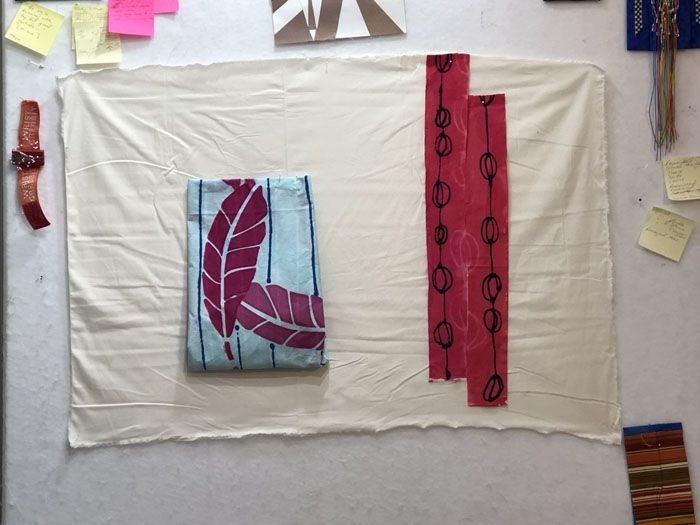
This time I switched the color proportions, using turquoise as my primary color and fuchsia as the accent. I still found it hard to incorporate the leaf fabric. Maybe because it had a lighter background? As you can see, I quickly over worked it.
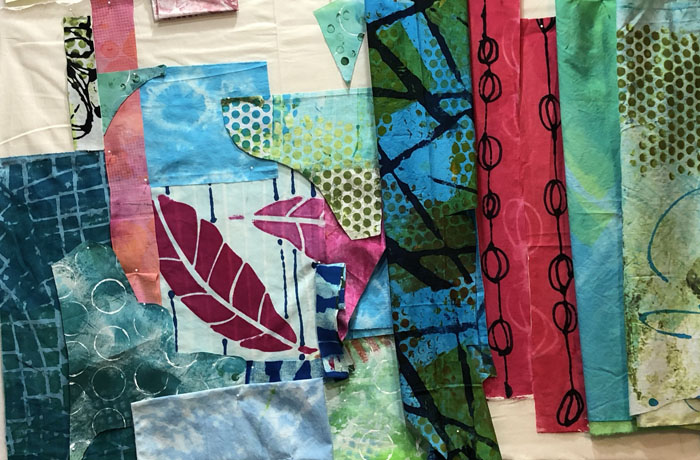
Have you heard the saying, “If something’s not working out (visually) remove your favorite thing?” Yeah. I slowly considered that I might need to remove the fuchsia leaf fabric and eventually did so, (reluctantly.) And, of course, things got much easier after that.
The background progressed well and I was very happy with it. It even showed off my fabrics, right?

On to a focal point. And I had the perfect specialty fabric for it.

But one strip of perfect fabric clearly couldn’t carry the whole piece. I knew I’d have to cut it into pieces to add some energy and to improve the composition.
BTW, I’m calling this “The robbing Peter to Pay Paul photo.” It shows what’s left of the original composition on the left design wall, as I reworked it on the right, using many of the previously cut fabrics.
OK, so I needed to mix things up a little. I decided to expand the color palette and to add additional smallish pieces. A quick audition confirmed this as the correct direction. Didn’t it gain a lot of energy from that?

I committed to cutting smaller shapes and I was really liking where this was going.
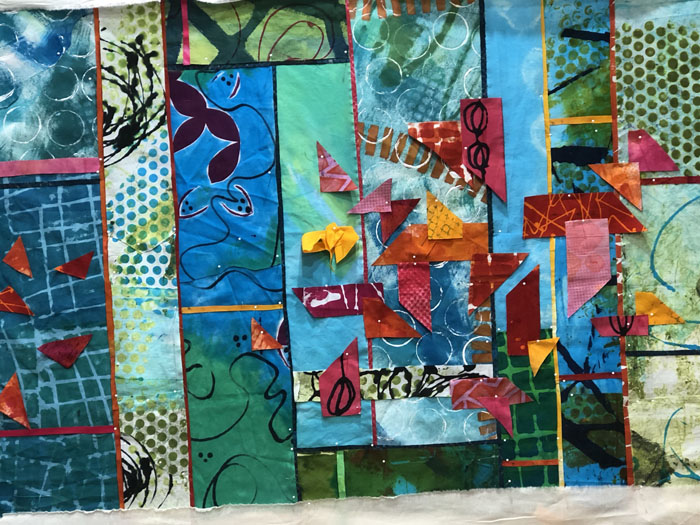
I was getting close. After finalizing the arrangement, I took lots of photos of the accent pieces and lifted them all off. Then I quilted the background with straight lines. At one point I put the background back on the design wall, but accidentally got it upside down (below.) I decided I liked that better.
Here’s the final arrangement pinned, and ready for gluing, then stitching/quilting.
I’ve had quite a time thinking of a name. Any suggestions? I’m leaning toward Underwater Dance, Shallow Water Dance, or just Water Dance. Do you think any of those work?
Ellen Lindner
P.S. Don’t you love my new lights on my design walls? I LOVE them!!! (See more of my recent studio revamp on my video page.)
As I mentioned in an earlier post, a specialty fabric or two can be the primary inspiration for an entire quilt. And that’s what I wanted to try.
This is sort of what I had in mind. I had intentionally dyed some large scale fabrics in order to try my hand at this. Plus, I had a few from earlier dye sessions. I thought I could do something with these, keeping the large scale pieces more or less intact, so their designs would still show.
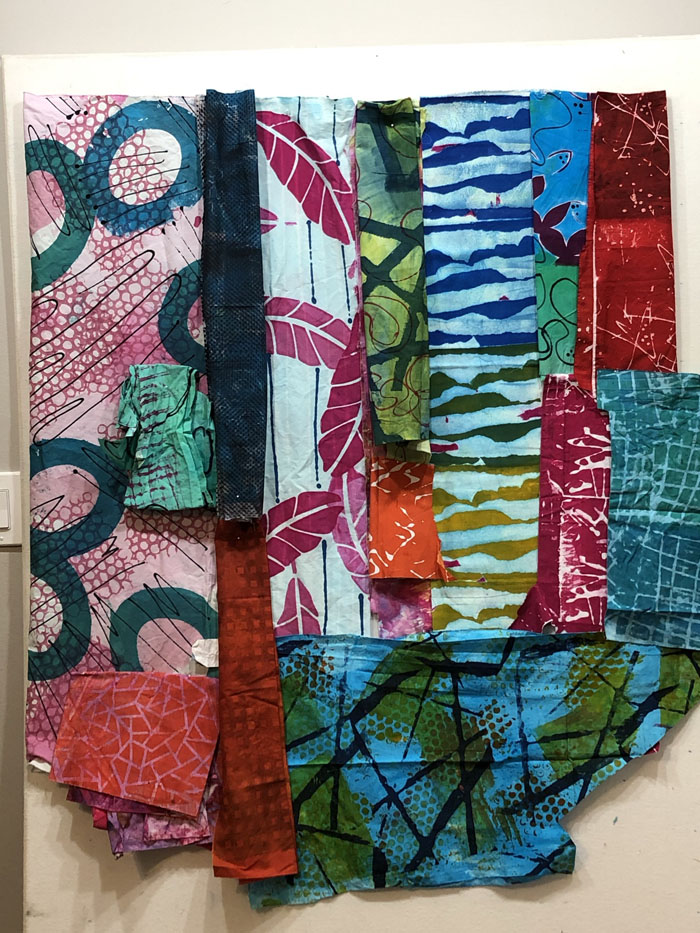
I put my muslin support fabric up on my design wall (nearly 4′ x 5′) and started auditioning fabrics. I almost immediately removed the large circles from the mix since I thought the colors looked a little muddy.

Hmm. I could see that the light blue fabric with fuchsia leaves was standing out A LOT. What to do? (Note that all fabrics are just folded and pinned in place at this point.)
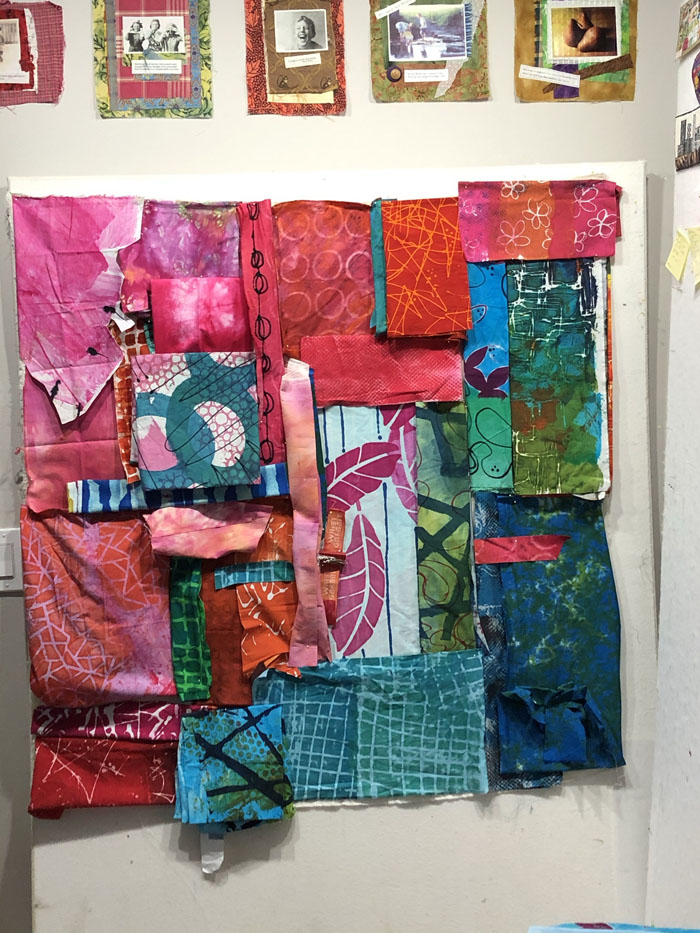
I made the highlight fabric smaller. And, of course, added the circles back. (Can you say “trial and error?)
I was loving the colors, but the composition was definitely lacking. I thought it needed some variety of scale, so I made some small units with scraps. (These are just glued to one another.)
Well, they look pretty exciting don’t they? But, how to best use them?

Those little pieces definitely added energy, but everything was looking pretty messy at this point. I decided I needed to commit to CUTTING fabrics, so I could see it all better.
Which is when I realized I had gotten way off track.

I was loving the colors, but I was having a terrible time using those large scale prints. Finally, I decided that my fabrics just weren’t large enough for this size quilt.
So, I started again, at about one quarter the original size.
I could immediately see that this was much more viable. On to round two.
BTW, I don’t fret when I have to rework something. Each “detour,” as I call them, has value. I learn from them. Typically, I’m excited to use that new knowledge as I plow ahead into the next thing.
How do you react to restarts?
Ellen Lindner
I finally got around to properly photographing my latest quilt, She Has a Great Personality. It’s meant to be a self-portrait in the style of a favorite artist. In this case, that artist is abstract painter Jane Davies.
I thought working abstractly would be difficult, but it wasn’t too bad. I had more trouble deciding on some of the details.
I added hand stitching in several areas to help tie it all together.
I’m very happy with it, and I think it represents me pretty well.
Ellen Lindner
Jeepers! I feel like the poster child for trial and error! While working on my latest quilt I had quite a difficult time deciding on what color to make one of the design elements.
The issue was the white circles, as seen below. I loved their shape and placement, but I could see that they attracted too much attention. I needed to tone down the contrast.
So, I started auditioning a variety of other colors. Yellow?
No. I figured it should be a lighter or darker version of one of the colors already in the quilt. Pink?
Nope. Pale aqua?
Uh-uh. Enough of these pastels. What about something bright?
Hmm. Not too bad. (Actually, I tried brighter orange fabrics and they seemed a little too much to me.) How about dark red?
I like this well enough to cut out the shapes.
Well, they were no longer attracting attention, but now I wondered if they showed up enough!
I FINALLY went back to orange, now in more subdued versions.
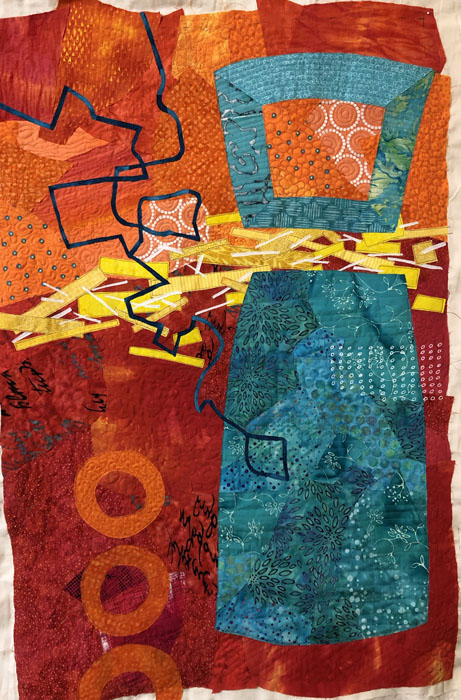
Would you believe it? I now thought the orange didn’t show up enough. Maybe I should add some darker hand stitching around each one.
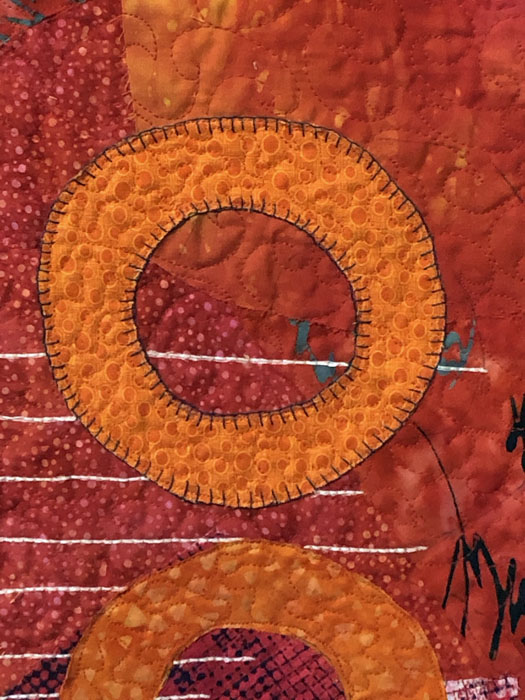
Maybe. Or would lighter thread provide more contrast?
Never one to make life easy for myself, I ripped out the dark stitching and redid it with yellow. I was FINALLY happy with it.
Whew! I’m giving myself a gold star!
What do you deserve a gold star for? Let me know and I’ll email you one.
Ellen Lindner
My raw edge collage techniques involves lots of layering. Sometimes perfectly wonderful fabrics get covered by something else later. However, I don’t typically rescue those underneath fabrics. Instead, I tell myself that I bought the fabric to use and if it’s function is to support later fabrics, and to give me flexibility then it has served me in a useful way.
But, on my current quilt, there’s a large shape that landed on top of the background. See what I mean?
So, I decided to rescue the red section underneath the largest turquoise shape. Both the red and turquoise sections were built on – and glued to – muslin, so I knew I could easily separate them.
But then I forgot.
Meanwhile, I started quilting the background, even though there were still foreground elements to be added. This was a logistical decision, since it will help me avoid all the starting and stopping that would otherwise be necessary to dodge all the things I intend to add.
About halfway through I remembered my earlier plans. So, I pulled up the batting as best I could on the lower portion. Some of it was already stitched down.
As you can see, I cut away the red portion, where able.
And I found two pins still stuck into that fabric! Good thing I did. I’ve had to cut them out a few times in the past.
But, since I was cutting from the back, I didn’t judge well and I actually cut into the background in the area I wanted to keep. Gulp!
But, since I work in raw edge collage, and quick patch took care of that.
Back to quilting!
Ellen Lindner
I like challenges. As a result, I’m currently working on an abstract self-portrait. It all came about when my art group, Dirty Dozen Fiber Artists, came up with (another) self-portrait challenge. This one was to be inspired by another artist.
After some online searching and thought I decided on one of my favorite contemporary artists, Jane Davies. She’s a painter and collage artist who does extraordinary abstract work.
Great, aren’t they? But, how do I make an abstract person? I remembered seeing one of her pieces (which I couldn’t find again,) that had a figure-like shape and I thought I could emulate that.
After creating an orange and red background, I auditioned the shape and placement of the figure with parchment paper.
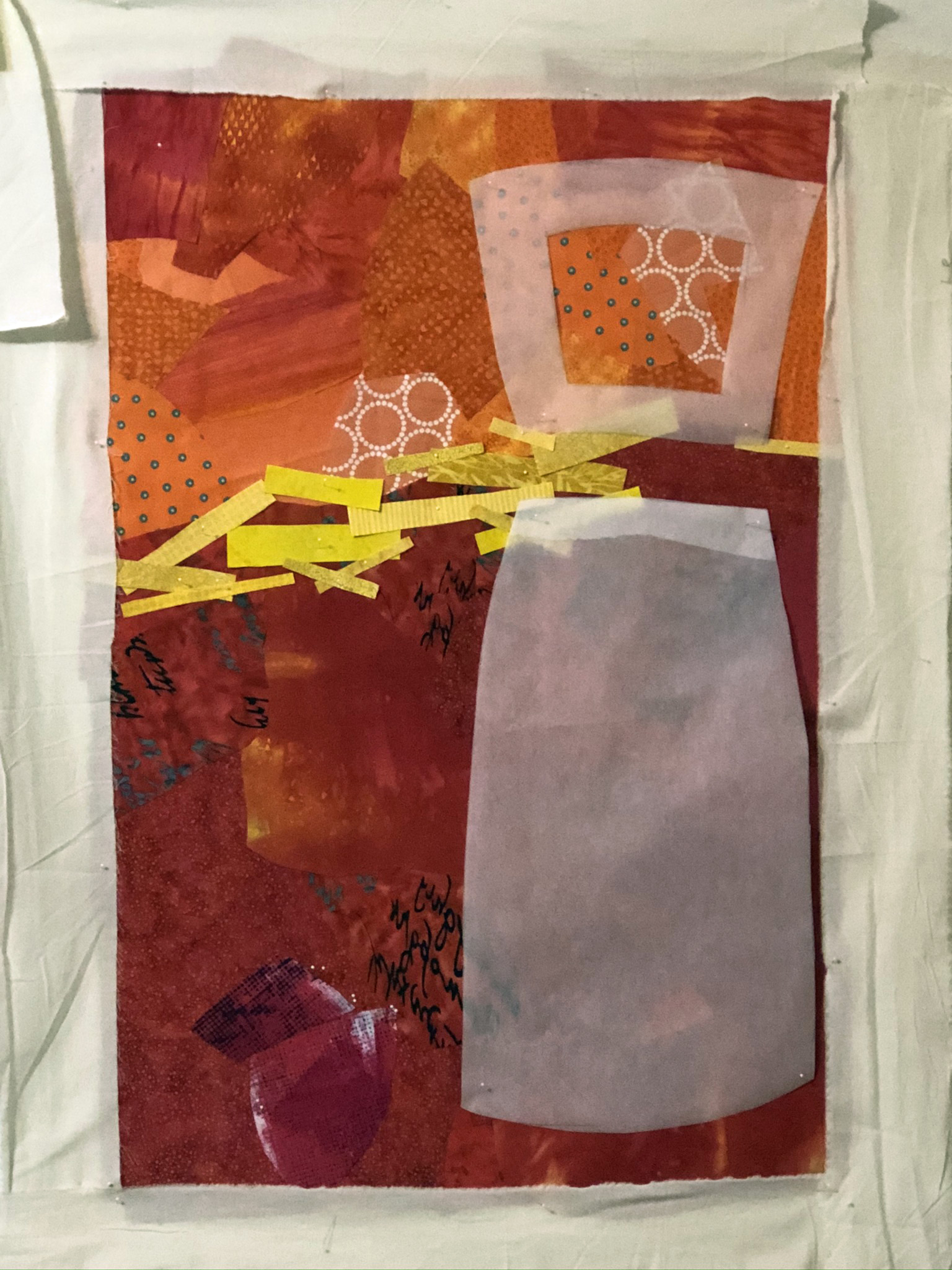
And then, the fabrics.
I think it works pretty well. What do you think?
I’ll be adding a squiggly black line to this – again in the style of Jane Davies. I’m really enjoying working on this!
Ellen Lindner
P.S. Jane Davies has some excellent free tutorials and a great book about painting abstracts.
When making Melting Pot, I was also considering whether I might have time to make a smaller quilt for another challenge. As Melting Pot grew, I decided to make it smaller and to use the remaining parts for this smaller quilt. Diversity is the result.
It was made for an exhibit called “1 x 4: Imagination.” As you can see, 1 x 4 refers to the dimensions: 1 foot wide and 4 feet tall. I modified the shape of the top and bottom, an effect I really like.
Like its sister quilt, Diversity was pieced improvisationally (with no pattern.)
I’ve spent a lot of time in the last few months shifting my teaching to online. That was a BIG time commitment and I didn’t have much time for creativity. Now, things have settled down and I’m easing back into quilt designing. Surprisingly, I had a little artistic block when I came back to it. I think that’s because I was so focused on black and white tasks for so many months, and my creative muscles were out of practice. Has that every happened to you? Now, I feel those old creative juices beginning to flow and it’s so much fun!
Ellen Lindner